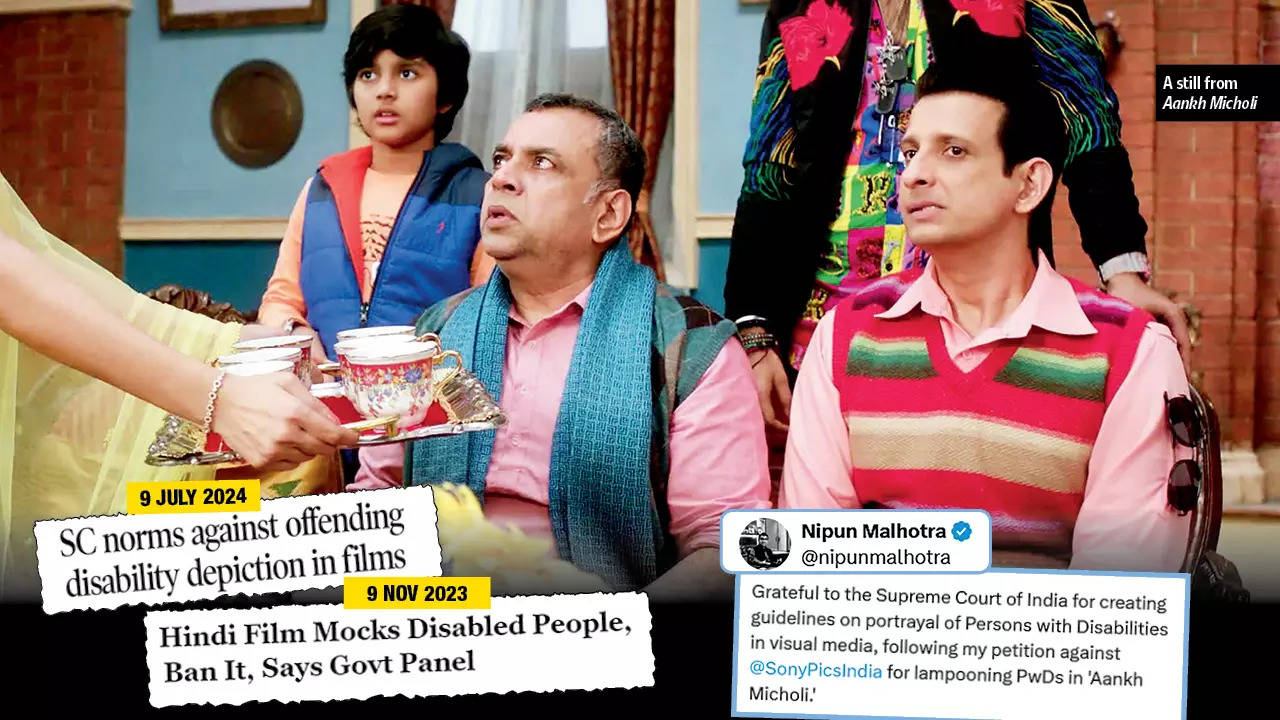what happened
■ On Monday, the Supreme Court laid down guidelines for sensitive portrayals of people with disabilities in visual media, emphasizing the distinction between ableism and crippling humour.
■The Court noted that creators need to be mindful of the difference between disability humour and ableist humour.
■ A bench of Chief Justice of India DY Chandrachud and Justice JB Pardiwala was hearing a plea regarding derogatory remarks against people with disabilities in Sony Pictures’ film “Ankh Micholi,” released last year. The Supreme Court said that a film-maker’s creative freedom under Article 19(1)(a) “does not include the freedom to caricature, stereotype, misrepresent or denigrate people who are already marginalized.”
Court statement:
“A distinction must be made between ‘disability humor’ that insults or belittles people with disabilities and ‘disability humor’ that challenges conventional wisdom about disability. Disability humor seeks to better understand and explain disability, while disability humor belittles disability. The two are not equal in their impact on dignity and disability stereotypes.” – Supreme Court
background
In January, the Delhi High Court refused to hear a PIL filed by disability rights activist Nipun Malhotra, who had alleged that the film “Ankh Micholi” contained derogatory language against people with disabilities.
He sought direction to the producers of the film to make a short awareness film on the difficulties faced by disabled people to create awareness on the subject. He also sought direction to the producers to ensure that an equal opportunity policy is formulated in accordance with the Rights of Persons with Disabilities Act (RPWD) and employment for disabled people is promoted.
The Delhi High Court had said that once the CBFC has certified a film, courts do not usually step in and that creative freedom should be respected and not restricted. After the Delhi High Court dismissed the petition, the matter moved to the Supreme Court.
SC Guidelines for On-Screen Representation of People with Disabilities
■ Avoid using words such as “disabled” that lead to systemic discrimination and promote a negative self-image.
■ Avoid language that ignores the social barriers faced by people with disabilities.
■ Visual media must reflect the lived experiences of people with disabilities and must not be one-dimensional, ableist portrayals.
■ Strive to portray people with disabilities as multifaceted, emphasizing their role as active community members who make meaningful contributions in many areas of life.
■ Ensure creators have access to appropriate medical information about disabilities such as night blindness to prevent discrimination
■ Do not portray people with disabilities as having superior senses, as this is not universally true.
■ Decisions should be made with an awareness of equal participation, following the principle that nothing is about us without us.
The film does not pity or look down on its characters: Producer
Disability rights activists have objected to the depictions in Ankh Micholi Nipun Malhotra, arguing that the film contains derogatory depictions of people with disabilities, including a false depiction of the condition night blindness, as well as derogatory depictions of people with disabilities.
■Alzheimer’s patients are called “Blacked-out bops”
■ “Soundproofing system” for the hearing impaired
■ Characters with speech impediments as “Atoki Fuika Set”
He argued that the film depicts a family of people with various disabilities and revolves around their attempts to hide their disabilities in order to be seen as a “normal family”.
Senior advocate Sanjoy Ghose appeared for Mr Malhotra along with advocates Jai Anant Dehadrai and Pulkit Agarwal.
Lawyer Sanjoy Ghose tweeted: “Perhaps for the first time, the Chief Justice watched a film clip in court. There were chuckles as the trailer was played on the giant screen. But the Chief Justice said he was looking at this from an ‘ableism’ perspective. The impact on disabled viewers will be entirely different.”
This portrayal is neither stereotypical nor insulting: Sony
Sony Pictures said the overall message of the film is “overcoming the challenges of disability.” It said the film sought to portray the struggles faced by people with disabilities and their families and their efforts to overcome them. In its response, the company asserted that the film sought to dispel the idea that disability prevents people from living a fulfilling life. It also said, “The presentation of the characters in the trailer is protected by freedom of speech and expression. The depictions are not stereotypical or derogatory. The film does not pity or belittle the characters but portrays their agency and skills.”

